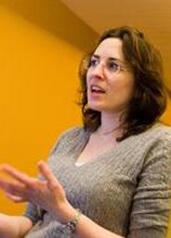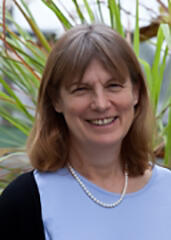
 Elena Kramer, Bussey Professor of Organismic and Evolutionary Biology, and Noel Michele Holbrook, Charles Bullard Professor of Forestry, co-teach General Education course OEB 52: Biology of Plants through lectures, labs, field trips, and weekly quizzes that students use to combine concepts into a creative project at the end of the semester. The prompt, “Trace the rise of the sporophyte,” results in the production of resources like videos, art pieces, fashion magazines, original songs, poems, and children’s books that students present in an arts festival during the final class.
Elena Kramer, Bussey Professor of Organismic and Evolutionary Biology, and Noel Michele Holbrook, Charles Bullard Professor of Forestry, co-teach General Education course OEB 52: Biology of Plants through lectures, labs, field trips, and weekly quizzes that students use to combine concepts into a creative project at the end of the semester. The prompt, “Trace the rise of the sporophyte,” results in the production of resources like videos, art pieces, fashion magazines, original songs, poems, and children’s books that students present in an arts festival during the final class.
Mastering course content through creative assignments
The benefits
Students have to refer back to course activities to help crystalize what they’ve been learning all semester, which ultimately helps them prepare for the final exam. Students tell Kramer the creative projects help them better understand course concepts: “It’s not just busy work, it’s not just fun; it actually makes them think about everything they’ve learned through the semester.”
The challenges
A standard grading rubric is difficult to apply to projects produced in various mediums. To address this issue, Kramer and Holbrook collaborated with a Media Fellow in the Derek Bok Center’s Learning Lab to design an accompanying activity in which all students record an introduction that explains their project and how it addresses the prompt. This “artist’s statement” is especially useful for evaluating the more abstract projects.
Takeaways and best practices
-
Offer an alternative.
To relieve some of the pressure students may feel in coming up with an original, artistic project, Kramer and Holbrook offer an alternative in the form of time-lapse videos. Students pick a topic like gravitropism or phototropism and then document their experience trying to capture it. -
Model creativity.
Kramer and Holbrook model a creative approach in at least one class meeting. Students watch as homework Holbrook’s lecture on plant transportation and in class use mixed media (dance, drawings, etc.) to demonstrate how the xylem and phloem work. -
Showcase.
In the final class session, students showcase videos and other digital projects, and present physical art-based projects in a poster session where their peers move from piece to piece and speak with one another about their work. All projects are then posted on the course Canvas site for students to refer to and use as a study tool for the final exam.
Bottom line
Combining science and art challenges students to take a concept in one field and express it another, giving them a chance to ruminate about how everything fits together. “You have to really understand the material to transfer it to another context or discipline,” says Kramer.
